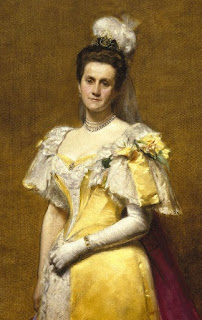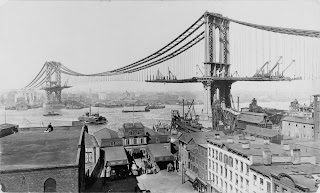 |
| Brooklyn bridge |
Emily Warren Roebling: The Woman Who Built the Brooklyn Bridge
The construction of the Brooklyn Bridge began in 1869 with an accident: John August Roebling, the famous designer and builder, was inspecting his new project in Manhattan when an oncoming ferry injured his leg.
Three weeks later, Robbing died of the resulting tetanus infection, and the chief engineer's job fell to his eldest son, Washington Roebling, who had been his father's right-hand man for the construction of the great bridge spanning the Ohio River at Cincinnati, as well as the design of the new bridge.
Three years later, Washington himself contracted "caisson sickness" (now known as decompression sickness), caused by the caisson chambers used in the construction of the bridge's underwater foundation.
His wife, Emily Warren Roebling, was given the job of handling the completion of one of the most impressive architectural achievements of the 19th century.
Emily Warren Roebling:
 |
| Emily Warren Roebling image source: Brooklyn museum |
When Washington Roebling met Emily Warren Roebling at a ball in early 1864, her older brother, General Gouverneur K. Warren, was Washington's commander during the Civil War - he immediately fell in love with her. The couple married in January 1865 in their hometown of Cold Spring, New York, and by 1867, when they traveled to Europe together, Emily was already pregnant. Their only child, John A. Roebling II, was born during the trip.
Washington's father, then working on the designs for the long-awaited East River Bridge project, sent his son across the Atlantic to explore the caissons, huge underwater chambers filled with compressed air that would then transform the construction of suspension bridges from London to Prague.
As preparations began for the new bridge project, Washington and Emily Warren Roebling moved into a house on Hicks Street in Brooklyn Heights, south of where the bridge would be built. Then, in the summer of 1869, after the sudden death of John Roebling, Emily's 32-year-old husband became chief engineer.
The Brooklyn Bridge was a radical new design.
The risks associated with building a 6,000-foot suspension bridge across the East River between Brooklyn and Manhattan were significant.
“It was a structure that had never been there before,” says Erica Wagner, biographer of Washington Roebling. “Everything about it was unprecedented. Everything was radical.
Workers first scraped away the bedrock, using shovels and dynamite, to settle two giant boulders that weighed several tons each. Above the water, huge stones were lifted to the top of the bridge towers with the help of iron cables. Sometimes the ropes broke, resulting in injury and death.
Emily Warren Roebling was "a strong tower to lean on".
Washington's illness damaged his sight and hearing and partially paralyzed him. However, his mind remained sharp, and he continued to supervise the construction of the bridge from his home in Brooklyn with the help of his wife.
As historian David McCullough wrote on The Great Bridge, Emily served as both a nurse and a private secretary, transcribing all of her husband's correspondence and keeping her notebooks. She also reviewed construction plans, visited the bridge and met with contractors and bridge managers.
As McCullough said, "She had a literally sharp eye, quick feet, a good right hand." When her envious people fueled the media with (fake) rumors that Washington had lost his mental powers, Emily also successfully fought them to keep him from being replaced as chief engineer at the end of the bridge's construction.
For his part, Washington Roebling has always given credit to his wife for her contribution to the construction of the bridge. He later wrote that "I thought I would give in, but I had a strong tower to lean on, my wife, a woman of infinite tact and wise counsel."
 |
| Brooklyn Bridge Construction |
Emily Warren Roebling opened the Brooklyn Bridge.
Ultimately, McCullough wrote that the Brooklyn Bridge would cost about $15 million to build, more than double John Roebling's original estimate, as well as the lives of about 20 people in addition to John himself.
The day before her grand opening on May 24, 1883, Emily Warren Roebling earned the honor of driving the first carriage across the completed Brooklyn Bridge.
Emily Warren Roebling's extraordinary achievements were not limited to her role in the construction of the Brooklyn Bridge. In 1899, at the age of 55, she graduated summa cum laude in women's law from New York University.
But just four years later, she died of stomach cancer at the Roebling's home in Trenton, New Jersey.
Engineer or not, Emily's influence on one of the world's most famous architectural icons remains undeniable. As Wagner says, "I think it's safe to say that the bridge couldn't have been completed without her."
Read also:
• Who posed for the Statue of Liberty?
• How tall is the Statue of Liberty?
• Statue of liberty original color | Why is the Statue of Liberty green?
• What is the statue of liberty holding in her left hand?
